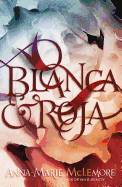
In Blanca & Roja, Mexican-American author Anna-Marie McLemore (The Weight of Feathers) tells a story that readers will, at first, likely interpret as fairy tale. All the elements are there: two sisters (one fair and gentle, one dark and fierce), a curse, handsome "princes." But McLemore takes the fairy-tale mold and reforms it to suit her own artistic needs.
Although the sisters, whose last name means "of the swans" in Spanish, have always known that one of them is destined to be turned into a swan, they are determined to fight this curse. As the legend goes, the swans will arrive soon after the younger of the two del Cisne girls turns 15. But, at an early age, sweet Blanca began feeding her fierce younger sister herbs and berries and white rose petals to sweeten her nature and confuse the swans. "If the swans can't tell us apart," she says, "they can't decide which of us to take." Roja's 15th birthday has come and gone, and the swan bevy has not shown up. However, a yearling bear and a baby swan have appeared. Are these creatures the nahuales their mother told them about, humans that can transform into animal forms? When the animals disappear and two missing local teens (one a boy, the other gender fluid) reappear, the possibility becomes closer to a certainty. Tension grows between the close sisters as they begin to question each other's actions and motives.
What sets McLemore's writing apart is the way her rich, beautifully ornamented language is shot through with a vein of proud feminism and the importance of owning one's identity. In the end, Blanca & Roja is about, as Blanca says, "giving up the stories we thought we already knew." --Emilie Coulter, freelance writer and editor

